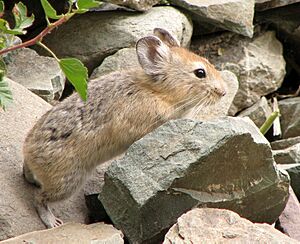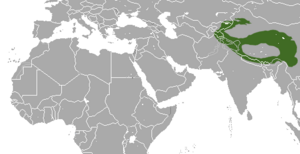Large-eared pika facts for kids
Quick facts for kids Large-eared pika |
|
|---|---|
 |
|
| at Ladakh, India | |
| Conservation status | |
| Scientific classification | |
| Genus: |
Ochotona
|
| Species: |
macrotis
|
 |
|
| Large-eared pika range | |
The large-eared pika (Ochotona macrotis) is a small, furry mammal. It belongs to the Ochotonidae family, which is related to rabbits and hares. These pikas live in the high mountains of Asia. You can find them in places like Afghanistan, Tibet, Bhutan, India, Kazakhstan, Kyrgyzstan, Nepal, Pakistan, and Tajikistan. They make their homes among large rocks and loose stones.
Contents
What Does a Large-Eared Pika Look Like?
The large-eared pika has brownish-grey fur. It often has a touch of yellow-brown color. Its forehead, cheeks, and shoulders can look a bit reddish, especially in the summer. The fur on its belly is greyish-white. All four of its legs are about the same length. Even the bottoms of its feet are covered in fur! An adult large-eared pika grows to be about 15 to 20 centimeters (6 to 8 inches) long.
Where Do Large-Eared Pikas Live?
Large-eared pikas live in the mountain ranges of Central Asia. Their home stretches across many countries. These include Afghanistan, Bhutan, India, Pakistan, Nepal, Kazakhstan, Kyrgyzstan, and Tajikistan. They also live in several provinces in China, like Gansu and Tibet. These pikas prefer high places. They can be found from about 2,300 meters (7,500 feet) up to an amazing 6,130 meters (20,113 feet) high in the Himalayas.
Pika Homes in the Mountains
Unlike some other animals, the large-eared pika does not dig burrows. Instead, it lives in natural cracks and spaces. These are found among the broken rocks and loose stones called scree in the mountains. This helps them stay safe and hidden.
Life and Habits of the Pika
Large-eared pikas are very protective of their space. Each adult pair will claim its own special area. They do not let other pikas enter their territory. In different places, you might find between 6 and 18 pikas living in an area the size of a football field. These small mammals are an important part of the mountain food chain. They are often hunted by various meat-eating mammals and birds of prey.
Diet and Reproduction
The large-eared pika is an herbivore, which means it only eats plants. It is also diurnal, meaning it is active during the day. Pikas munch on grasses and other plants. They also eat twigs, lichens, and mosses. Some groups of pikas collect dried grasses. They pile them up in their rocky homes. These "haypiles" help them have enough food to eat during the cold winter months.
Female pikas usually have two litters of babies each year. Each litter has about two or three young pikas. The mother carries her babies for about 30 days before they are born. The young pikas grow up quickly. They are ready to have their own babies by the next breeding season. A large-eared pika usually lives for about three years.
Pika Conservation Status
We don't know the exact number of large-eared pikas in the world. However, they live across a very large area. They also seem to be quite common in their mountain homes. Scientists have not found any major threats to this species. Because of this, the IUCN (International Union for Conservation of Nature) has listed the large-eared pika as "Least Concern" on its Red List of Threatened Species. This means they are not currently in danger of disappearing.


